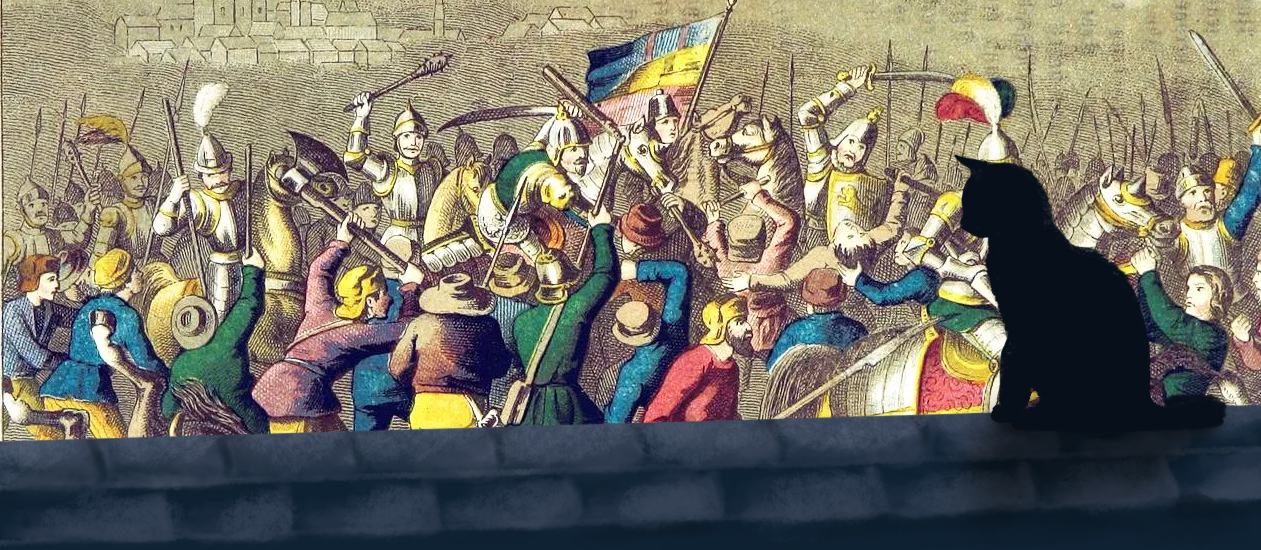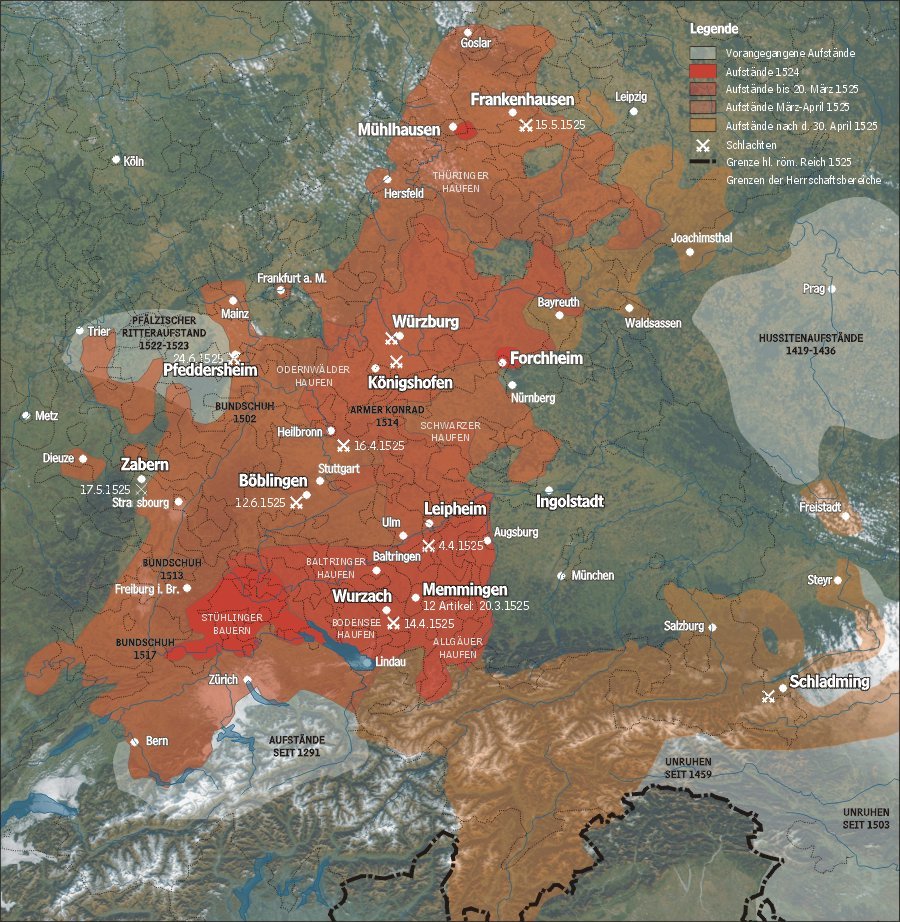Great Peasants' War
Forward, forward, while the iron is hot. Let your swords be ever warm with blood!
The first democracy of early modern Europe was won through blood. This war saw an uprising of serfs fed-up with feudalism stand up to the noble authorities and, with a little help from Ireland, throw off their shackles to create the Federated Almain States .
The Conflict
Prelude
For centuries, peasants in the Holy Roman Empire were powerless serfs. The nobility grew wealthy from their labour and exacted high taxes. This was seen as simply the natural hierarchical order of the world, in parallel to the hierarchy of the church.
This began to change in 1519 when Martin Luther published his 95 Theses. The Bible was published in Almain in 1522 and disseminated by the printing press, spreading it to the masses. Never before had common people been able to read the Bible on their own. In the past, they had relied on Latin-speaking clergy members to provide the interpretation.
Upon reading the Bible themselves, the people noticed that it said nothing about a pope or structure of bishops. The hierarchy that ruled their lives was man-made, they claimed, and Protestantism spread. This combined with class struggle. If the hierarchy of the church was wrong, then the hierarchy of class was as well. Unrest began to spread in the southwest region of the Holy Roman Empire.
In the town of Stühlingen in 1524, the Countess of Lupfen ordered serfs to collect snail shells for use as thread spools after a series of difficult harvests. Within days, 1,200 peasants had gathered, created a list of grievances, elected officers, and raised a banner. The spark of the uprising spread, and within a few weeks, the entire region - Baden, Tyrol, the Black Forest, and into parts of Bavaria - was embroiled in open revolt, rallied by preacher and revolutionary Thomas Müntzer.
The Engagement
In the first few months of the war, the peasant army made steady progress through the region. They secured cities and ousted the noble elites that ruled them. Their army grew as they progressed, as locals from towns they conquered joined the march.
The first major setback was the Massacre at Frankenhaus, where the militias of Philip I of Hesse and George of Wettin defeated the peasants with their well-trained and well-equipped soldiers. The next few months saw a series of defeats for the peasants. Although their army was larger, the response from the local authorities had significantly more financial support, equipment, and training.
The major turn in the war came in January of 1525, when the first troops from Ireland arrived. Ireland, the birthplace and stronghold of the Arbitrium Church, saw this as a chance to disrupt Catholic hegemony in continental Europe.
Union with Ireland
Ireland provided troops but more significantly, money and supplies. Irish soldiers took command of many untrained peasant regiments to lead them to victory. In June of 1525, France entered the war on the side of the Holy Roman Empire. They saw the uprising as an affront to the natural order and feared that allowing the peasants to succeed would set a terrible example for the oppressed serfs in their own country.
As this took place during the War of the League of Cambrai, troops were pulled away from the nearby Venetian front in order to focus on the peasant uprising. This had already been happening with the Holy Roman Empire, and was one of the reasons the HRE ultimately pulled out of that war and left it to the Papal States. Distracting Catholic powers with a second war had been another of Ireland's goals - the establishment of the Church of Venice threatened the Pope's power.
The Irish/Peasant army secured more and more territory throughout the rest of 1525, until finally signing a peace treaty in March of 1526, ending the war with a peasant victory.
Aftermath
The victory of the peasants led to the creation of the Federated Almain States in 1526, one of the first true democracies in Europe. This state became a Protestant haven in Europe which was otherwise torn between the Catholic Church and Arbitrist churches.
The war also occupied the time and resources of the Holy Roman Empire during the War of the League of Cambrai, aiding Venice in victory. This led to a more powerful Venice and diminishing power for the Papal States.
Due to Ireland's integral alliance during the war, Ireland and Almany remain close allies to the present day despite their religious differences.
Conflict Type
War
Battlefield Type
Land
Start Date
October,1524
Ending Date
March, 1526
Conflict Result
Victory for the Peasant Army
Belligerents
Almany and Ireland
Feudal Authorities
Strength
Peasants: 300,000
Irish: 20,000
Irish: 20,000
Germans: 8,500
French: 15,000
French: 15,000
Casualties
Peasants: 20,000
Irish: 6,000
Irish: 6,000
Germans: 4,000
French: 5,000
French: 5,000
Objectives
Peasants: To establish a democratic country freeing them from the abusive feudal system
Irish: To disrupt Catholic hegemony in continental Europe
Irish: To disrupt Catholic hegemony in continental Europe
Put down the uprising and re-affirm feudal authority




